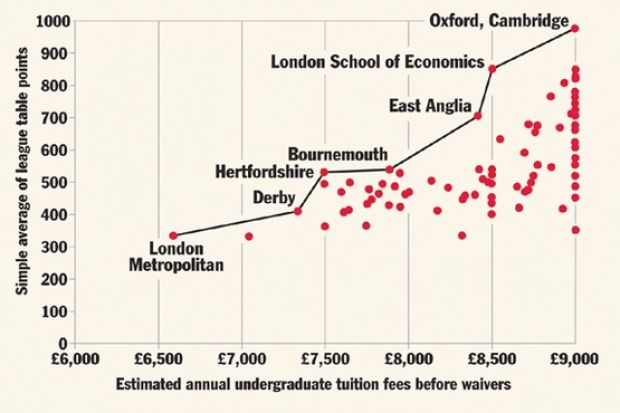Oxbridge, the London School of Economics, the University of Hertfordshire and London Metropolitan University may seem unlikely bedfellows, but they share the distinction of offering the best value for money in England, a new analysis suggests.
Statisticians at Hertfordshire have compared the tuition fees of 95 English universities against their league rankings. Using a composite of four university rankings tables - The Times, The Sunday Times, The Guardian and The Complete University Guide - to assess performance, they plotted a graph against average pre-waiver fees to indicate "value for money".
Oxbridge scored highest in the £9,000-a-year category, while LSE came top of the cluster of £8,500-a-year institutions and Hertfordshire performed best at the £7,500 mark.
Despite its relatively lowly rankings performance, London Met was judged to offer the best value at the lower end of the fee spectrum.
The line linking institutions on the graph (see related files, right) is pitched as a "value-for-money frontier", with distance from it denoting poor value for money.
Those furthest from the frontier include the University of East London, Middlesex University and Liverpool John Moores University.
Quintin McKellar, vice-chancellor of Hertfordshire, claimed the chart would help students to pick a university next year. "This gives them the opportunity to look clearly at league table performance compared with the amount they will pay," he said.
Professor McKellar also said he was "entirely confident" in the methodology used by the Hertfordshire statisticians who rated their own institution so highly.
"Many institutions have given lots of money to fee waivers and that makes a difference to the shape of the graph," he conceded, but said it allowed students to make a "very straightforward" comparison.
He said the chart could force some institutions to lower their price.
Malcolm Gillies, vice-chancellor of London Met, said that while it might be a "crude exercise", it would be useful to students. He said that if the table was refined, with fee waivers taken into account, the results would not be radically different.
"The issue of institutional risk is interesting," he said. "A simplistic interpretation of the diagram would suggest that as you move further away from the value-for-money frontier, the greater the risk being taken."
But Liam Burns, president of the National Union of Students, dismissed it as a "promotional exercise that will leave prospective university applicants none the wiser".
Register to continue
Why register?
- Registration is free and only takes a moment
- Once registered, you can read 3 articles a month
- Sign up for our newsletter
Subscribe
Or subscribe for unlimited access to:
- Unlimited access to news, views, insights & reviews
- Digital editions
- Digital access to THE’s university and college rankings analysis
Already registered or a current subscriber? Login
